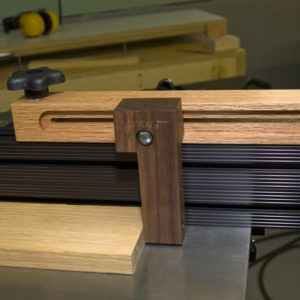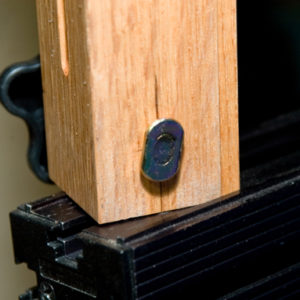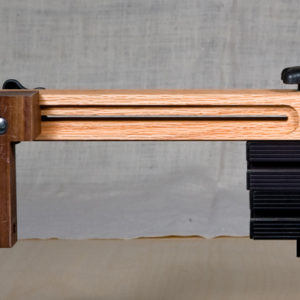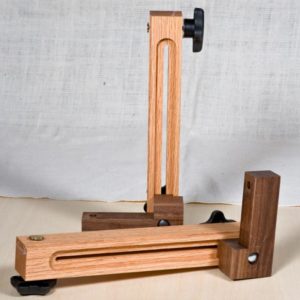Lee Valley Router Fence Stops

I designed and fabricated these several months ago because I had a real need to control start and stop routing positions which were wider than the router bench top. Those of you who use this fence might have a similar need.
The images should hopefully be self-explanatory.
Briefly, the stops fit into the top of the fence and slide laterally as you see fit. In addition, each arm is slotted for further lateral adjustment. The perpendicular arms are fitted with brass insert-nuts at their lower ends. This allows for the use of 1/4-20 bolts to facilitate fine adjustment if necessary. The Left Stop photo has this hardware installed. The Right Stop photo does not.
Phillip Anthony























Replies
Those are very handsome and look quite well-made. Someone's gonna ask, so I might as well.....is there an advantage over the Lee Valley stops made for the Veritas fence? (they run $25 ea.) I haven't bought stops for my fence yet, so am interested in your opinion!
View Image
Girl,As the OP mentioned, his stops can be stretched out beyond the fence ends to facilitate control of bigger workpieces. I never had the need for this myself but can appreciate the gubbins, as the LV stops won't go as far.I do have and use the LV stops, which are typically well made and function very well, especially in respect of the micro-adjust screws. If I have a longer workpiece needing s groove or similar, I tend to put the work piece in the (LV twin screw) bench vise and move the router over it freehand using a twin router-fence arrangement on longer-than-normal fence rails to control the cut. A QR clamp at either end of the workpiece, or even on the bench top edge, makes for the stops.Lataxe
Ah, good question, but then again, I know you use this quality tool from Veritas, so I would expect as much. Couple of points here, which are co-related:Point 1
Regardless what I'm doing, safety is always on my mind. Always. So, one of my reasons for making these was because I prefer not to have an overly large fence-opening gap about the bit, meaning that if the LV stops are needed off table, this would force me to extend the lower halves of my fence thus creating this wide horizontal void. Now, of course, you are thinking that I could use a sacrificial/auxilliary fence to overlay the gap. Yes, that is true, but this would have to be custom made to insure that the T-bolts match the fence tracks when the lower fence is fully extended at both ends, which is doable, I agree. But, I am finding that my bench drawer is stuffed with 'custom' fences. My stops have put an end to this. So far, anyway.Point 2
The Veritas fence stops can be used with a limited-height (11/16 x 3/4-inch) sacrificial/auxilliary fence, but in this case, the stops must be tracked into the upper-half of the fence, which (1), is fixed in length and (2) this vertically short fence is not very stable or safe when routing a board vertically. So, dependent on work piece, the Veritas stop may or may not work for you. My stops were made to fit over a taller 1/2-inch sacrificial/auxilliary fence making them, IMHO, much more flexible in terms of usable range and ability to work with/without a sacrificial/auxilliary fence.In all of this, I am in no way saying that my creations are superior to Lee Valley's. Only a fool would make such a claim. My stops simply allow me to safely rout my workpiece without making any compromises.Photo explanations:
Left Stop in Xtended Use: shows the extended range of the stops;Left Stop w/Sacrificial Board: shows stop overlaying auxilliary fence;LV Stop_001: shows LV stop tracked into a not-very-usable position;LV Stop_002: shows LV stop overlaying a short-height auxiliary board, which you showed in your original post. Pardon the duplicity which I just realized.I hope I have answered your question.Phillip Anthony
I am in now way knocking you fence and stops. I see you have the stops raised a 'bit' so the sawdust/chips go onder and do not collect to ruin the next cut.
I have suggestion.. Make the stops with a knife point if your stops are made of hardwood. Yes, it can be a broblem if the stick you are cutting do not line up with the knife point as a wider 'stick' would..
The pointed edges was something that I considered back when and that is a good suggestion. However, what is more of an issue is - just as you said, what if your piece misses the edge, then what??My workflow is such that I vacuum up after every rout and when I'm really feeling picky, I blow off my router table with air from my air compressor. Time consuming for sure, but if you want it right the first time, you have to be careful and clean up after every rout.Thanks for the good suggestion.Phillip Anthony
Phillip
what if your piece misses the edge, then what?? A stop with multiple V's to let the sawdust out? :>)
Just funnin ya a bit!
Thanks for the detailed insights, Phillip, very helpful! I haven't done much routing on taller stock, or really long stock, but after getting chastised awhile back for doing stopped dadoes on my table saw, the next time I'll turn to the router. If it's a repeat on the same project (have had a couple of people interested), I'll be needing extended stops and may copy-cat yours!
forestgirl -- you can take the girl out of the forest, but you can't take the forest out of the girl ;-)
Edited 11/2/2008 11:06 pm by forestgirl
Glad I could help, Jamie. Being fortunate to have LV/Veritas gear is a blessing, IMHO. Augmenting it to accomplish what we dream of doing is the crux of what most of us do. And that is simply designing/creating these rigs which allows us to, as they say, "git'r done!"Take care,
Phillip Anthony
This forum post is now archived. Commenting has been disabled